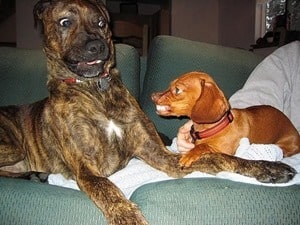The key factor to effective Dog Aggression training is to determine what’s causing the aggression in the first place. An effective method of working with or training the dog can be developed after you understand what triggers aggression for your dog. Remember that some breeds are more aggressive than others, and will need a more controlled environment and possibly specialized training and socialization.
So, why do dogs become aggressive? Why do they bite or attack us? There are several factors attached to these issues. The most prominent one is, owners failing to control, supervise, maintain and properly train the breed of dog they choose to keep. Now, the Question is, is it possible to stop dogs from behaving aggressively towards human beings, children and other smaller animals? Yes, it is possible. It is possible to stop dog aggression by using Aggressive Dog Remedy Products.
Territorial situations

Guarding behavior
This issue is not unique to puppies, but is easiest to deal with when the dog is young before the behavior is established. Pet and talk to the puppy while it is eating, and let it understand that you may take things away from it, but you will provide something back. For dogs that snap or nip when you try to remove objects try having the dog sit and attach a leash before picking up the object. Reward the dog when it stays seated and does not nip. Provide a treat as well as lots of positive attention for this behavior. Never tease a dog with food or toys, and talk to children in the family about this behavior.
Transferred Aggression
There are some situations that are out of the owner’s control, especially when the problem causing aggression isn’t in your yard. You can build a fence or try planting bushes to separate your dog from the irritation. Dogs should always be trained to sit and wait for human response, giving time for the dog to calm itself and allow itself to be pet without showing aggression. Dogs that are kept together may need to be separated if one of the dogs is displaying transferred aggression.
Fear Situations
Dogs that get aggressive situations that cause fear need to be reinforced with confidence and reassurance. Take some time and work with your dog to build self confidence. be sure to take it slow and reward any progress, slowly working up to greater challenges. A socialization class can help this type of dog after its become used to new environments. Be sure to make experiences with new situations and environments positive, at least at the beginning. Watch for signs of stress that your dog may be exhibiting and be sure to remove them to stop dog aggression.
Dominance
If your dog growls at you when you ask it to get off the couch or if it doesn’t respond to you the dog may feel more dominant than you are. This can be a problem as the situation will not change unless you change your behavior. A dominant dog needs to understand that you are the pack leader. Crate training may be beneficial. Rewarding the dog for following directions is important. Avoid any games of strength like tug of war or wrestling with dominant dogs. Keep the dog on a leash when you are walking and make sure that you are going where you want to go, not where the dog wants to do. A professional trainer or an obedience class may be necessary to change the behavior of both the owner and the dog.

We have a daniff puppy who had parvo, she was hospitalzed and made a recovery. However she has been kept in the house and yard for several weeks with no outside
interactions. Problem she nips, hard, ankles , gets very anxious a few times a day and I have scabs to, prove it. We put her time out smack her nose. put her on her back , nothing works, Help